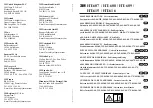
Altai Technologies Ltd. All rights reserved
C1n Series WIFI AP/CPE Web-admin Configuration Manual
TPS15-003_rev1.3
Max Tx/Rx Streams
: Specify the maximum number of transmission streams and
receiving streams in 802.11n MIMO. The default value is 2 for both transmission and
receiving stream.
Beacon Interval Auto
: Radio0 adjusts the beacon interval itself in order to reduce the
beacon frame overhead in wireless network.
Beacon Interval
: Specify interval of beacon transmissions of each supported BSS.
Each BSS share this setting. The unit is in term of millisecond (ms). The beacon interval
can be configured between 40 and 3500ms. The default setting is 100ms, i.e. 10
beacons per second.
DTIM
: Specify the interval between two DTIM; this message is generated to inform the
associated clients about the presence of buffered multicast/broadcast data on the
access point. The unit is in term of second. The range is from 1 to 255. The default
value is 1.
Fragmentation Threshold
: Specify the frame size of each frame. Frames that are
smaller than the specified fragmentation threshold value will not be fragmented;
otherwise, the frames will be fragmented into smaller packets and transmitted a
piece at a time instead of all at once. The unit is in term of Byte. The range is from 256
to 2346 bytes. The default setting is 2346 bytes. It is recommended to use the default
value or only minor reductions of this default value.
Protection Mode
: Specify the protect mechanism on hidden node problem of Wi-Fi
network. This mechanism can decrease the rate of data collision wireless stations.
When the protection mode is enabled, the throughput of the AP will be a little lower
due to many of frame traffic should be transmitted.
There are 3 options: “None”, “CTS-only” and “RTS-CTS”.
“None” – no protect mechanism is used. It is the default setting.
“CTS-only” – also known as CTS-to-Self; AP issues a CTS frame to itself before sending
data. All clients will not transmit during the time.
“RTS-CTS” - AP sends a RTS frame, waits for the clients CTS frame and then sends the
data packet. It allow more robust operation, but at the expense of additional
overheads.
Protection Rate
: Specify the transmission rate of protection frame, i.e. CTS frame and
RTS frame.
RTS/CTS Threshold
: If a frame is smaller than the RTS/CTS threshold, it will be sent by the
AP without modification. If a frame is larger than the RTS/CTS threshold, then two
frames will be sent by the AP. The first frame is an RTS (request to send) frame. After
the RTS frame is sent, the AP listens for the corresponding CTS from the target client.
















































